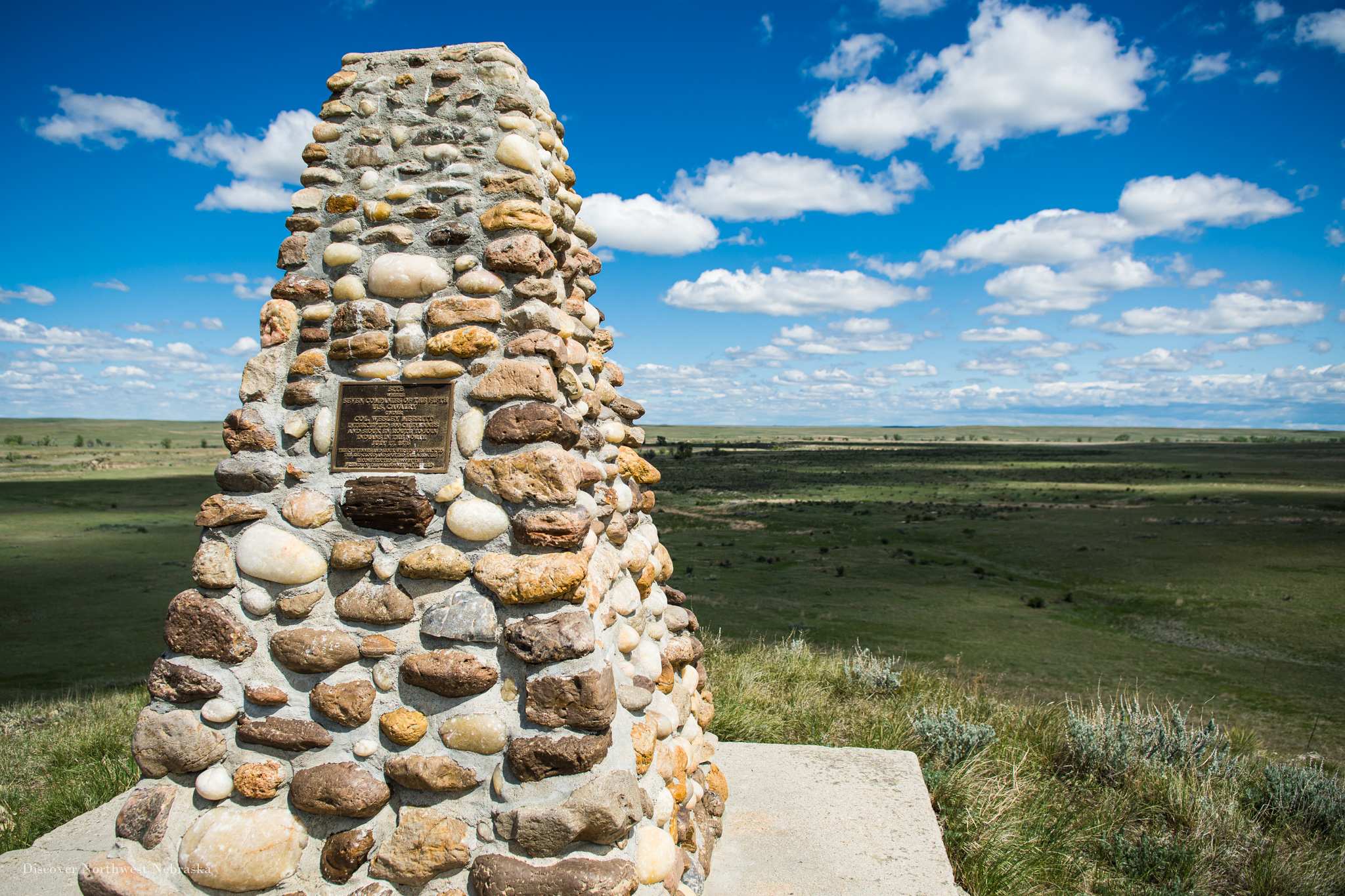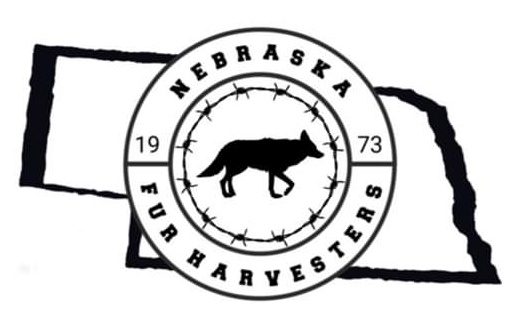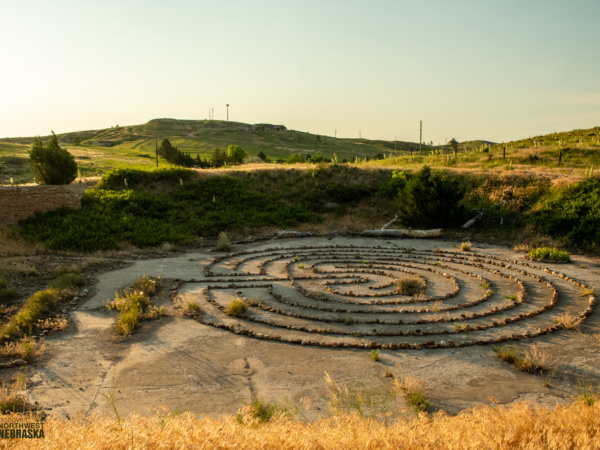By Kerri Rempp
Discover Northwest Nebraska
Hiding behind trees, high on hills or along back roads, monuments often created out of rocks or boulders from nearby fields recognize the state’s rich – and often forgotten – history.
Jeff Barnes, author of “Marking Nebraska: Our (Mostly) Hidden Historical Monuments,” who appeared at the Mari Sandoz High Plains Heritage Center in December, became so intrigued by the historical monuments he stumbled across he deliberately began researching them.
“These are not the state historical markers – the blue tablets,” Barnes said. His book includes more than 300 monuments, many made out of boulders with a plaque attached. Some are easy to find, others require a hike up a hill or are located on private property where permission must first be obtained in order to see them.
“They tended to place these where the history happened,” he said.
Barnes’ book covers monuments all across the state, including border markers. The first border monument was placed in 1854 at the Nebraska-Kansas border and was essentially forgotten for years, making statewide news when it was rediscovered, Barnes said. Northwest Nebraska has its own border monument denoting where Nebraska, South Dakota and Wyoming converge. Dubbed the “Common Corner Monument,” it was placed in 1869 and today is located on private property and is difficult to reach; as such, Barnes left it out of his book.
Other monuments recognize important trails across Nebraska – the Lewis and Clark Trail or the Oregon Trail, for example – while still others are dedicated to early pioneer settlement or recognize the contact between the European settlers and the Native Americans.
“(The monuments) range from the familiar to the unfamiliar,” Barnes said.
Monuments such as those Barnes references in his book can be found throughout Northwest Nebraska.

Contact Between Cultures
The Cheyenne Outbreak Monument and the Warbonnet and Yellow Hair Monuments all fall into the “contact between cultures” category.
The Cheyenne Outbreak Monument, located along Highway 20 west of Fort Robinson on land owned by Dull Knife College, was dedicated in 2016 and is the newest monument in the region. It took 15 years for Dull Knife College to complete construction of the monument, which is dedicated to the Northern Cheyenne who fled imprisonment at Fort Robinson.
The Northern Cheyenne surrendered at Fort Robinson in 1877 after their village in the Bighorn Mountains was burned; they were eventually sent south to present-day Oklahoma. Suffering from disease and poor nutrition, the Cheyenne left Oklahoma without permission to return to their tribal lands in the north in 1878, led by Morning Star (aka Dull Knife) and Little Wolf. The tribe split in to two groups as they crossed Nebraska, with Morning Star planning to join Chief Red Cloud at the Red Cloud Agency. Red Cloud, however, had been relocated to Dakota Territory, and Morning Star surrendered to Fort Robinson in October 1878, seeking permission to either join Red Cloud or return to Montana. His negotiations were unsuccessful, and the government began withholding food, fuel and water to force a return south.
On Jan. 9, 1879, a group of the Northern Cheyenne broke out of the barracks, escaping toward the buttes. A running battle with Fort Robinson’s soldiers took place over the next several days, before the remaining tribe members were recaptured Jan. 22 near Antelope Creek northwest of Fort Robinson. All told, 64 Cheyenne and 11 soldiers were killed during the breakout and the ensuing battle.
Though the entrance to the monument is gated, visitors are allowed to pass through the gate to visit the monument. Please remember to close the gate after you’ve passed through both entering and leaving.
The Warbonnet and Yellow Hair Monuments mark an encounter between the United States’ 5th Cavalry, including scout Buffalo Bill Cody, and a group of Cheyenne near Warbonnet Creek in 1876. Located just north of the Immaculate Conception Catholic Church and the now-defunct town of Montrose north of Harrison, the monuments require a hike to reach.
Warbonnet, high on a hill, overlooks the area and recognizes the events of the Battle of Warbonnet Creek, in which the 5th Cavalry turned away a group of Cheyenne – rumored to number up to 800 – who were attempting to join Sitting Bull in the weeks following his victory against General Custer. The hill on which the monument sits would later house a civilian built fort that served to protect Montrose during tensions that arose during the Ghost Dance.
Back down the hill and to the east, closer to the county road, is the Yellow Hair Monument, dedicated to the only casualty of the battle. At this site, William “Buffalo Bill” Cody killed and scalped the Cheyenne Yellow Hair (sometimes incorrectly called Yellow Hand) as he and a group of warriors were attempting to cut off a pair of couriers trying to reach the main 5th Cavalry forces. Cody claimed the scalp as “the first scalp for Custer,” and later featured it in his wild west shows. Though the battle had just one casualty, it was considered a rare victory for the U.S. during the fighting in 1876.


Early Pioneer Settlement
The Dawes County Courthouse square is known as Mary E. Smith-Hayward Square, dedicated to a prominent businesswoman who settled in Chadron in the 1800s.
Hayward was born in Pennsylvania but struck out on her own in 1885. After arriving in Nebraska, she took a claim west of Chadron and also opened a dry goods business in town (her building still stands today and is located on Second Street). She was president of the Nebraska Women’s Suffrage Association in the 1890s, and refused to pay taxes in 1895 to protest women’s inability to vote. She represented Nebraska in the Women Suffrage Parade in Washington, D.C., in 1913, marching with 8,000 other attendees.
Hayward was also an animal rights activist and a lifelong member of the Humane Society. She came out against the famed Chadron-Chicago Horse Race in 1893 and once had a man arrested for beating his horse.
The Chadron Business and Professional Women’s Club dedicated the square in her honor in 1998, and two memorials – a rock memorial on a concrete slab on the north side and a concrete bench near the courthouse – recognize the Business and Professional Women’s Club and Smith-Hayward.
The square also has a monument dedicated to all early pioneers in Northwest Nebraska. Located on the east side of the square near the courthouse, the rock monument is dedicated to the “valor of the pioneers 1885-1935.” It was constructed of local rocks.
To learn more about Northwest Nebraska’s monuments, state historical markers and museums that provide context of the region’s history, visit https://discovernwnebraska.com/museums-and-markers/.





